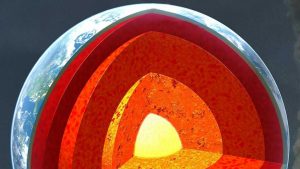
Examining conditions within the Earth’s interior is crucial not only to give us a window back to Earth’s history but also to understand the current environment and its future.
This study, published in Nature Communications, offers an explanation of carbon’s descent into the deep Earth. “The stability regions of carbonates are key to understanding the deep carbon cycle and the role of the deep Earth in the global carbon cycle.” says Leonid Dubrovinsky, from the University of Bayreuth.
This is where the ESRF, the European Synchrotron in Grenoble, France. comes in. “The intense X-rays from the ESRF allow us to access the extreme conditions within the entire Earth’s mantle.” underlines Valerio Cerantola, lead author, former PhD student at the University of Bayreuth and now postdoctoral scientist at the ESRF.
In the last century, the rapid increase in the amount of CO2 in the atmosphere together with the observed climate change have increasingly focused scientists’ attention on the carbon cycle and its evolution at the Earth’s surface. The carbon cycle also extends below the surface: recent estimations locate up to 90% of the Earth’s carbon budget in the Earth’s mantle and core. Due to the dynamic nature of tectonic plate movements, convection and subduction, there is a constant recycling of carbon between the Earth’s surface and its deep interior.
In this study, the research team focused on carbonate phases, which are one of the main carbon-bearing minerals in the deep mantle. Carbonates are a group of minerals that contain the carbonate ion (CO32-) and a metal, such as iron or magnesium. The scientists studied the behaviour of a pure iron carbonate, FeCO3 (called siderite), at extreme temperature and pressure conditions covering the entire Earth’s mantle, meaning over 2500 K and 100 GPa, which corresponds to roughly one million times the atmospheric pressure.
“This iron carbonate is of particular interest because of its stability at lower mantle conditions due to spin transition. Moreover the crystal chemistry of the high-pressure carbonates is dramatically different from that at ambient conditions.” explains Elena Bykova, from the University of Bayreuth.
In order to study the stability of FeCO3, the research team performed high pressure and high temperature experiments at three ESRF beamlines: ID27, ID18 and ID09a (now ID15b). “The combination of the multiple techniques gave us unique datasets that ultimately allowed us to uncover new C-carriers inside the deep Earth and show the mechanism behind their formation” says Cerantola. One experimental run was carried out at beamline 13ID-D at APS.
Upon heating FeCO3 to Earth geotherm temperatures at pressures up to about 50 GPa, FeCO3 partially dissociated and formed various iron oxides. At higher pressures, above ~75 GPa, the scientists discovered two new compounds — tetrairon (III) orthocarbonate, Fe43+C3O12, and diiron (II) diiron (III) tetracarbonate, Fe22+Fe23+C4O13.
“There were some theoretical predictions, but so far experimental information about structures of high pressure carbonates have been too limited (and indeed controversial) to speculate about carbonate crystal chemistry. Our data show that while crystal structure of Fe22+Fe23+C4O13 could be found in silicates, no analogues of Fe43+C3O12 are found in nature.” underlines Bykova.
They also found out that one phase, the tetracarbonate Fe4C4O13, shows unprecedented structural stability and keeps its structure even at pressures along the entire geotherm to depths of at least 2500 km, which is close to the boundary between the mantle and the core. It thus demonstrated that self-oxidation-reduction reactions can preserve carbonates in the Earth’s lower mantle. “The study shows the importance of oxidation and reduction (redox) reactions in the deep carbon cycle, which are inevitably linked to other volatile cycles such as oxygen.” underlines Catherine McCammon, from the University of Bayreuth.
Reference:
Valerio Cerantola, Elena Bykova, Ilya Kupenko, Marco Merlini, Leyla Ismailova, Catherine McCammon, Maxim Bykov, Alexandr I. Chumakov, Sylvain Petitgirard, Innokenty Kantor, Volodymyr Svitlyk, Jeroen Jacobs, Michael Hanfland, Mohamed Mezouar, Clemens Prescher, Rudolf Rüffer, Vitali B. Prakapenka, Leonid Dubrovinsky. Stability of iron-bearing carbonates in the deep Earth’s interior. Nature Communications, 2017; 8: 15960 DOI: 10.1038/NCOMMS15960
Note: The above post is reprinted from materials provided by European Synchrotron Radiation Facility.










